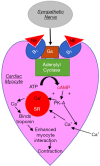Reverse Takotsubo cardiomyopathy: a comprehensive review
- PMID: 30603648
- PMCID: PMC6312810
- DOI: 10.21037/atm.2018.11.08
Reverse Takotsubo cardiomyopathy: a comprehensive review
Abstract
Takotsubo cardiomyopathy (TTC) was first described in Japan in the 1980s. It is described as an acute but often reversible left ventricular (LV) dysfunction mainly triggered by emotional or physical stress. Multiple variants of TTC have been reported including reverse Takotsubo cardiomyopathy (rTTC) which is a variant characterized by the basal akinesis/hypokinesis associated with apical hyperkinesis that resolves spontaneously. The hallmark of rTTC is a clinical presentation similar to an acute coronary syndrome (ACS), with no evident obstructive coronary artery disease. The incidence of TTC is estimated to be 2% of all troponin-positive patients presenting with suspected ACS. The proportion of patients presenting with the rTTC variant out of all TTC patients in published literature has been variable, ranging from 1-23%. Reverse Takotsubo has been associated with younger age, less decrease in left ventricular ejection fraction (LVEF), and more neurological disease compared to the TTC. While the exact mechanism of rTTC is unknown, hypothesized mechanisms include catecholamine cardiotoxicity, coronary artery spasm, coronary microvasculature impairment, and estrogen deficiency. Patients with rTTC typically present with chest pain and/or dyspnea after an emotional or physically stressful event. rTTC can also be triggered by intracranial hemorrhage, general anesthesia, or neurological conditions. Diagnosis of rTTC requires the presence of LV basal hypokinesis/akinesis, new electrocardiogram (EKG) abnormalities or elevated cardiac troponin, and absence of obstructive coronary disease, pheochromocytoma, or myocarditis. Management of rTTC is similar to that of TTC, which is predominantly supportive with the treatment of complications. The recurrence rate of rTTC is around 10%. The most common complications of rTTC include myocarditis, pleural and pericardial effusions, and development of LV thrombi. The best predictors of mortality include decreased LVEF, development of atrial fibrillation, and neurologic disease.
Keywords: Cardiomyopathy; Takotsubo; heart failure; reverse-Takotsubo; stress.
Conflict of interest statement
Conflicts of Interest: The authors have no conflicts of interest to declare.
Figures
References
-
- Dote K, Sato H, Tateishi H, et al. Myocardial stunning due to simultaneous multivessel coronary spasms: a review of 5 cases. J Cardiol 1991;21:203-14. - PubMed
Publication types
LinkOut - more resources
Full Text Sources

